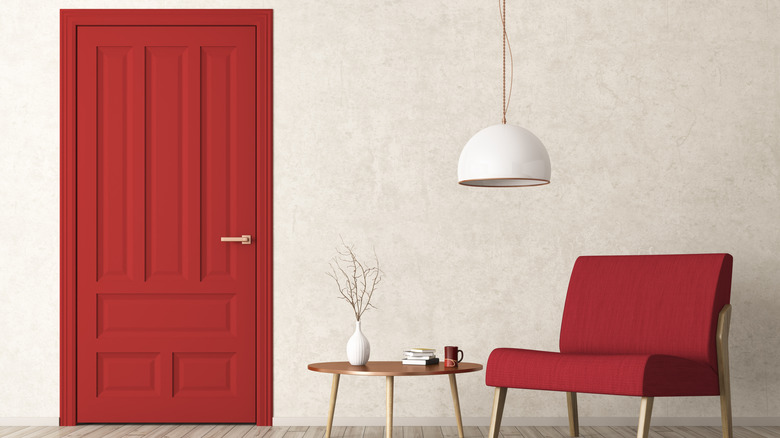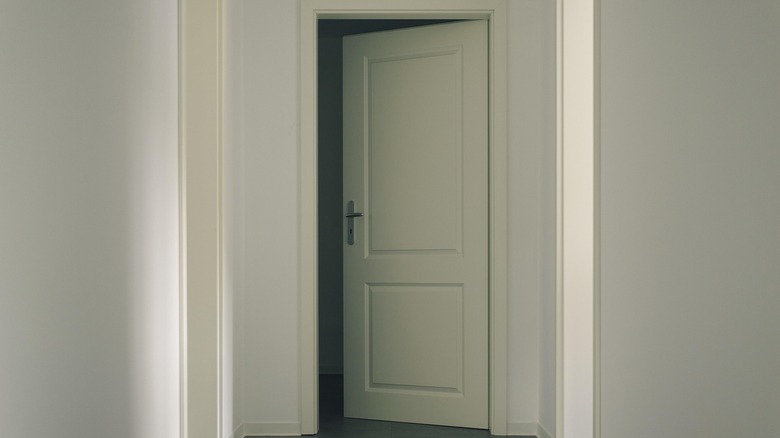6 Paint Colors That Are Perfect For Interior Doors (And 5 To Avoid At All Costs)
Painting has long been the perfect way to inexpensively update a space, and opting to paint a door (versus the dreaded task of painting an entire room) can be an even simpler, more budget-friendly way to get a design upgrade in any room. As a small area, interior doors are easy to paint with a limited amount of time and pack the most punch in terms of design. If you're looking for a weekend upgrade, take a close look at your interior doors. Tackle the hardest part of this project first by choosing a paint color.
Finding the right paint color isn't as simple as just considering your favorite hue, though that does play an important part. But you also need to consider which shades will work best for your home's — or more specifically that room's — existing design and color scheme. On top of that, you can't forget to take into account the size of the room, the type of lighting, and the color of all your decor. If it all feels a bit daunting, no worries. Interior designers have weighed in on their preferences for interior door colors (including the classics like black, white, or gray) as well as a few they strongly advise you avoid altogether, like lime green or bright red.
Perfect interior door color: black
If you're craving dark and bold, consider black for an interior door as an effortlessly elegant addition to any room. Include other black accents within the space to ensure your statement door feels harmonious. Otherwise, the black door will feel disconnected and disrupt the aesthetic. Any shade of black will create a door that serves as a striking and timeless focal point. Pair the new dark hue with unforgettable colors that go with black, plus warm features like brick floors. Finish up the space by layering your lighting to bring depth and warmth.
Color to avoid: red
Exterior doors may benefit from a striking color like red, but inside, it's typically a no-go. A bright red door can be garish and is hard to design around. It's an intense, attention-grabbing color (which is why it can be the perfect front door color to boost your home's curb appeal), but inside, it can pull too much from the rest of the room. Unless you can design around the color correctly, too much of this bright shade often comes off as aggressive and can promote negative feelings, making it hard to relax.
Perfect interior door color: gray
Gray interior doors give you more freedom in your room's design. They are flexible with the surrounding color palette and create a moodier tone without going too bold. Lighter shades of gray will allow other areas of the room to serve as focal points, while darker shades can be a striking way to draw attention to a space. Gray interior doors will serve as a soft base for your chosen room, which can then be designed with complementing white accents for a modern and inviting finish.
Color to avoid: orange
Another harsh color to nix when it comes to interior door design is orange. Just as you wouldn't paint an accent wall orange, you shouldn't color block an interior door with the color either. It's one of the most hated colors for a reason, and for many, it's just too bright of a color that can easily overwhelm. There are other ways to incorporate the color if you wish — like with smaller accent pieces. Pair pops of orange with a black, sage green, or dark gray interior door for a vibrant but balanced room.
Perfect interior door color: natural greens
Earthy tones are taking over the interior design world, and green doors are an excellent way to hop on this trend. Green paints come in shades to suit your vibe, whether its light or dark that's whispering into your ear these days. If you're up for the bolder look, forest green will add a dramatic nod to nature. For a lighter and more subdued option, a sage green with a beige undertone will create an airy and earthy space. Combine your green door with complementary colors and accents like gold, black, or natural browns.
Color to avoid: lime green
Though you could experiment with lime green in some spaces, it's not recommended as an interior door color in most cases as the hue is just too bright. The vibrancy of lime green can easily overwhelm a space and take away from the comfortable feel you want to inspire inside your home. With so many other perfect interior door colors out there, it's best to avoid this unnatural shade of green. For a pop of neon color, keep it to smaller accents so you don't overburden the room with the shade.
Perfect interior door color: light or navy blue
Blue is a beloved color for interior designers, and just as it serves well in other aspects of color in the home, it can be perfect for your inside doors. There are many shades you can choose from, ranging from a light powder blue to a dark, moody navy blue. These shades pair well in bedrooms or bathrooms where they can evoke a calming and airy atmosphere. Pair your lighter shade of blue with comforting finishes like wood accents, blankets, and linens, and complement navy shades with brass touches.
Color to avoid: royal blue
Notice a theme to the colors you should avoid for your interior doors? Yep, overly vibrant colors are not the way to go here. Just like the overwhelming brightness of red, orange, and lime green, royal blue is too vibrant for its own good. Lighter or darker shades can work for interior doors, but the tone of royal blue just doesn't fit the bill and can come off feeling too juvenile. Though not as large as an accent wall, an interior door is still a big area to paint with such a saturated tone.
Perfect interior door color: dark brown
Dark brown tones make for dynamic interior doors. These shades are being lauded by designers as making a serious comeback and interior doors are great options to tie the color into your home. Dark brown doors elevate areas like a bedroom or a home office by creating a warmly luxurious space. This shade of interior doors pair excellently with natural materials like rustic wood mantels or stone floors. Decorate the rest of the room with various textures like leather or velvet for a layered, lived-in space.
Color to avoid: builder-grade beige
Nothing is more blah and boring than those builder-grade paint shades. A home becomes a home when it's lived in and made unique, and that just can't happen with this shade. Its generic vibe is unloved by most and should be avoided on large areas like interior doors. That doesn't mean you need to go bold, though. There are subtle neutral options (like the aforementioned gray) that can help personalize your interior doors. Just make sure you stay away from this tone of beige if you don't want your doors to feel drab and lifeless.
Perfect interior door color: white
Though white may seem basic, it's a staple door color for a reason. It can work as an anchor of crispness in a room and serve as a neutral foundation for bold accents. Either way, you can't go wrong with timeless white. Keep in mind there are many shades of white, all of which can look different depending on the space. Use color swatches to ensure you get a shade that complements the tone and lighting of the room. To add architectural interest to your white door, consider a paneled door design.




